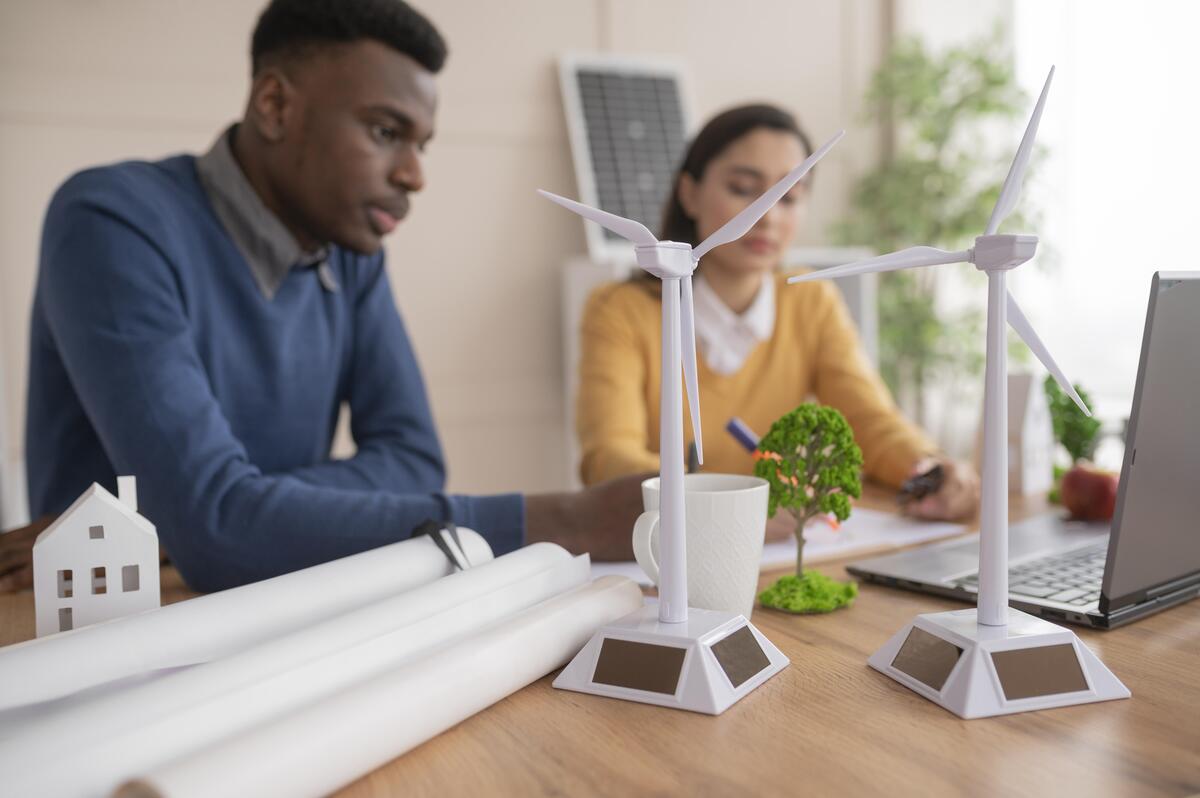Building decarbonization stands at the forefront of the global battle against climate change, commanding attention as a critical avenue for reducing carbon emissions. Buildings, responsible for nearly 40% of the world’s carbon footprint, present an urgent challenge and an unparalleled opportunity in the quest for sustainability.
Statistics underscore the staggering impact of building emissions: an estimated 28% of global energy-related carbon emissions stem from the energy consumed in heating, cooling, lighting, and operating buildings. Furthermore, the construction industry, a key player in erecting these structures, contributes about 8% of global carbon emissions due to the energy-intensive production of materials like cement and steel.
This formidable carbon footprint is compounded by inefficiencies within existing buildings, where outdated systems and inadequate insulation drive excessive energy consumption. The incessant demand for new structures due to rapid urbanization further amplifies the emissions conundrum, necessitating a reimagining of construction practices and operational standards.
The forthcoming exploration delves into the intricate web of challenges and solutions in building decarbonization. From the burgeoning potential of technological advancements to the pivotal role of policy frameworks, financial considerations, and the vital engagement of communities and stakeholders, this discourse navigates through the complex landscape of sustainable building practices. The pursuit of building decarbonization emerges not merely as an environmental imperative but as a cornerstone for forging resilient, efficient, and equitable structures that will shape the future of our planet.
Table of Contents
What is Building Decarbonization?
Building decarbonization refers to the systematic reduction of carbon emissions generated by the construction, operation, and maintenance of buildings. It represents a crucial strategy in mitigating climate change, considering that buildings account for a substantial portion of global greenhouse gas emissions. This concept encompasses a comprehensive approach to minimizing carbon footprints associated with both residential and commercial structures.
At its core, building decarbonization involves transitioning away from traditional fossil fuel-based systems towards cleaner and more sustainable alternatives. This transformation spans various aspects of a building’s lifecycle:
- Construction Materials: Building decarbonization begins at the construction phase by adopting materials with lower embodied carbon. This involves choosing eco-friendly materials, minimizing waste, and utilizing innovative construction techniques to reduce the initial carbon footprint of a building.
- Energy Consumption: Buildings are significant energy consumers. Building decarbonization targets this aspect by focusing on energy-efficient designs, incorporating renewable energy sources like solar or wind power, and optimizing heating, cooling, and lighting systems to reduce energy demand.
- Technological Innovation: Advancements in technology play a pivotal role in building decarbonization. Smart building systems, IoT (Internet of Things) applications, and energy-efficient appliances contribute to reducing energy consumption and optimizing building performance.
- Policy and Regulations: Governments and regulatory bodies play a vital role in driving building decarbonization efforts. Implementing building codes, standards, and incentives that promote sustainable construction practices and energy-efficient designs can significantly accelerate the shift toward building decarbonization.
- Occupant Behavior: Encouraging sustainable habits among building occupants, such as energy conservation practices, waste reduction, and conscious water usage, contributes to overall building decarbonization efforts.
Suggested article to read: Zero Energy Buildings (ZEB); Comprehensive Guide 2024
Building decarbonization is not only an environmental imperative but also an economic opportunity. While initial investments may be necessary to adopt green technologies and sustainable practices, the long-term benefits, including reduced energy costs, improved health and well-being for occupants, and a decreased environmental impact, outweigh these upfront expenses.
Moreover, the transition to building decarbonization aligns with global efforts to achieve carbon neutrality and combat climate change. As societies strive to meet ambitious emission reduction targets, the transformation of the built environment becomes increasingly essential.
In essence, building decarbonization represents a holistic approach that encompasses innovative technologies, sustainable practices, policy interventions, and behavioral changes aimed at significantly reducing carbon emissions associated with buildings, thereby fostering a more sustainable and environmentally conscious future.

Current State of Building Emissions
Currently, building emissions stand as a pivotal challenge in the global pursuit of carbon reduction. Buildings contribute significantly to greenhouse gas emissions, accounting for nearly 40% of the world’s carbon footprint. This substantial share stems from various sources within the construction and operation lifecycle of buildings.
The primary contributors to building emissions include energy consumption for heating, cooling, lighting, and appliances, accounting for roughly 28% of global energy-related CO2 emissions. Fossil fuels, predominantly natural gas and oil, remain the primary energy sources for heating and powering buildings in many regions. Their combustion releases carbon dioxide, contributing significantly to building emissions.
Additionally, construction materials and processes wield a considerable impact. Cement, a primary component in concrete used extensively in construction, is responsible for approximately 8% of global carbon emissions due to its energy-intensive production process. Other materials like steel and glass, prevalent in modern buildings, also contribute significantly to emissions during extraction, manufacturing, and transportation.
Suggested article to read: Nearly Zero Energy Buildings (NZEB); Ultimate Guide 2024
The inefficiency of existing buildings compounds this issue. Many structures lack adequate insulation, use outdated heating and cooling systems, and rely on inefficient appliances, leading to excessive energy consumption and higher emissions. In developed nations, where older buildings often remain in use, retrofitting and upgrading to meet modern efficiency standards pose a pressing challenge.
Moreover, urbanization trends exacerbate the problem. Rapid urban growth worldwide has led to an increased demand for new buildings, resulting in higher emissions during both the construction and operation phases. Urban sprawl and inefficient zoning policies sometimes lead to increased transportation needs, further escalating carbon emissions.
However, efforts to address building emissions have gained traction. Green building certifications, such as LEED (Leadership in Energy and Environmental Design) and BREEAM (Building Research Establishment Environmental Assessment Method), promote sustainable construction practices and energy-efficient designs. These certifications incentivize the adoption of renewable energy sources, efficient materials, and environmentally conscious construction methods, thereby reducing emissions over a building’s lifecycle.
In conclusion, the current state of building emissions reflects a critical environmental concern. Addressing this issue necessitates a multi-faceted approach involving advancements in technology, policy interventions, and behavioral changes. From embracing renewable energy to implementing stringent energy efficiency standards, concerted efforts are crucial to mitigate building emissions and transition toward sustainable and carbon-neutral structures.
Challenges in Decarbonizing Buildings
Decarbonizing buildings presents a complex set of challenges stemming from technological, financial, regulatory, and behavioral aspects. Addressing these hurdles is crucial for achieving meaningful reductions in carbon emissions. Here are the key challenges:
- High Initial Costs:
- Upgrading buildings with energy-efficient technologies often requires significant upfront investment, deterring many building owners from undertaking such projects.
- Cost-effective solutions need to be developed to make building decarbonization financially feasible for various stakeholders.
- Diverse Building Stock:
- The diversity in building types, ages, and uses poses a challenge as each structure may require a unique approach for building decarbonization.
- Retrofitting older buildings with modern, energy-efficient systems without compromising structural integrity or historical value can be particularly challenging.
- Technological Limitations:
- The availability and maturity of certain technologies, especially for deep building decarbonization, can be limited.
- Finding scalable and affordable technologies that suit different building types and climates remains a hurdle.
- Regulatory Barriers:
- Existing regulations might not prioritize or mandate the adoption of sustainable building practices.
- Lack of standardized policies and unclear regulations can hinder the widespread adoption of building decarbonization measures.
- Split Incentives:
- In cases where tenants and landlords share responsibility for energy costs, the incentives for either party to invest in building decarbonization measures may be misaligned.
- Finding mechanisms to bridge this gap and incentivize all stakeholders is crucial.
- Behavioral and Awareness Challenges:
- Building occupants might not fully comprehend the environmental impact of their energy usage, leading to resistance or apathy toward adopting energy-saving behaviors.
- Education and awareness campaigns are needed to promote behavioral changes that support building decarbonization efforts.
- Infrastructure and Grid Constraints:
- Scaling up renewable energy sources for buildings might face challenges related to grid capacity and infrastructure readiness.
- Integration of decentralized energy sources like solar panels requires grid upgrades to accommodate bidirectional power flow.
- Data Access and Privacy Concerns:
- Implementing smart technologies for energy management might raise concerns about data privacy and security, potentially hindering their adoption.
Addressing these challenges will require a multi-faceted approach, involving collaboration between governments, industries, technology developers, and communities. Innovative financing models, supportive policies, technological advancements, and concerted efforts to raise awareness and change behavior are essential to overcoming these hurdles in building decarbonization.

Technological Solutions
Technological solutions play a pivotal role in building decarbonization, offering diverse ways to reduce energy consumption and transition to sustainable practices. Here are some key technological solutions:
- Energy-Efficient HVAC Systems:
- Advanced heating, ventilation, and air conditioning (HVAC) systems with higher efficiency ratings reduce energy consumption while maintaining optimal indoor comfort.
- Technologies like heat pumps, geothermal systems, and district heating/cooling improve efficiency and reduce reliance on fossil fuels.
- Building Envelope Improvements:
- Upgrading insulation, using high-performance windows, and employing reflective roofing materials enhance a building’s thermal performance, reducing heating and cooling demands.
- Smart materials that adjust insulation properties dynamically based on environmental conditions offer innovative solutions.
- Renewable Energy Integration:
- Installation of solar panels, wind turbines, or small-scale hydroelectric systems on-site or nearby allows buildings to generate renewable energy, reducing dependence on the grid.
- Energy storage solutions, like advanced batteries or thermal storage systems, optimize the use of intermittent renewable sources.
- Smart Building Technologies:
- IoT-enabled sensors, smart meters, and building management systems facilitate real-time monitoring and control of energy usage.
- AI-driven algorithms analyze data to optimize energy consumption, predict maintenance needs, and adjust systems for maximum efficiency.
- Energy-Efficient Appliances and Lighting:
- High-efficiency appliances and LED lighting significantly reduce electricity consumption.
- Smart lighting systems with occupancy sensors and daylight harvesting features further optimize energy usage.
- Building Energy Management Systems (BEMS):
- BEMS integrates various technologies and systems within a building to optimize energy use and improve overall operational efficiency.
- These systems allow for centralized control and management, enabling adjustments to reduce waste and improve sustainability.
- Electrification of Heating and Cooking:
- Transitioning from natural gas or other fossil fuel-based systems to electric-powered heating and cooking appliances helps eliminate direct carbon emissions within buildings.
- Electrification coupled with renewable energy sources contributes to a more sustainable energy mix.
- Green and Sustainable Materials:
- The use of eco-friendly and sustainable construction materials, such as recycled steel, bamboo, or low-impact concrete, reduces the carbon footprint associated with building materials.
Implementing these technological solutions requires a combination of investment, supportive policies, market incentives, and public awareness. As technologies evolve and become more accessible, their integration into building design and operation will be instrumental in achieving significant reductions in carbon emissions from the built environment.
Suggested article to read: Sustainable Construction Technology; Ultimate Guide in 2024
Policy and Regulatory Frameworks
Policy and regulatory frameworks are crucial in driving the adoption of sustainable practices and accelerating the building decarbonization. Here’s an overview:
- Building Codes and Standards:
- Establishing stringent energy efficiency standards for new constructions and renovations sets a baseline for sustainable building practices.
- Regular updates and enforcement of building codes ensure that structures meet or exceed minimum energy performance requirements.
- Energy Performance Certificates (EPCs):
- Requiring EPCs for buildings provides transparency on their energy efficiency, enabling buyers, tenants, and owners to make informed decisions.
- EPCs can incentivize upgrades by highlighting areas for improvement and showcasing the potential energy savings.
- Incentive Programs and Financing Mechanisms:
- Government incentives, subsidies, or tax breaks encourage building owners to invest in energy-efficient technologies and retrofits.
- Financing mechanisms such as green bonds, low-interest loans, or grants help offset the initial costs of adopting sustainable practices.
- Mandates and Targets:
- Setting clear targets for reducing carbon emissions or increasing renewable energy adoption within the building sector provides a framework for action.
- Mandates for specific energy-efficient technologies or renewable energy integration drive industry compliance and innovation.
- Zoning and Land Use Regulations:
- Incorporating sustainability criteria into zoning and land use regulations encourages environmentally friendly building designs and urban planning.
- Regulations promoting mixed-use development, transit-oriented design, and green spaces can reduce energy demand and promote sustainability.
- Public Procurement Policies:
- Government agencies can lead by example by implementing procurement policies that prioritize sustainable building practices.
- Procuring energy-efficient technologies and materials for public buildings sets a benchmark for the private sector.
- Research and Development Support:
- Funding research and development initiatives for innovative technologies and materials support the advancement of sustainable building practices.
- Collaboration between governments, academia, and industry drives innovation and the development of cost-effective solutions.
- International Cooperation and Agreements:
- International agreements and collaborations facilitate the exchange of best practices, knowledge sharing, and harmonization of standards across borders.
- Participation in global initiatives enhances a country’s commitment to addressing climate change and accelerates the adoption of sustainable building practices worldwide.
Effective policy frameworks need to be comprehensive, flexible, and adaptive to technological advancements and changing societal needs. Collaborative efforts between governments, industry stakeholders, advocacy groups, and the public are essential for the successful implementation and enforcement of these policies.

Financial Considerations
Financial considerations play a pivotal role in building decarbonization, and influencing the adoption of sustainable practices and technologies. Here’s an overview:
- Upfront Costs and Return on Investment (ROI):
- High initial costs often deter building owners from investing in energy-efficient upgrades or renewable energy systems.
- Calculating and showcasing the ROI through reduced operational expenses (lower utility bills), increased property value, and potential incentives can incentivize investment.
- Incentive Programs and Subsidies:
- Government-backed incentive programs, subsidies, or tax credits help offset the upfront costs of adopting energy-efficient technologies or green building practices.
- Financial support encourages building owners to make sustainable investments by reducing the payback period.
- Green Financing and Loans:
- Specialized financing options such as green bonds, energy-efficiency mortgages, or green loans offer favorable terms and rates for sustainable building projects.
- These financial instruments specifically cater to projects aimed at reducing carbon emissions and promoting sustainability.
- Energy Performance Contracts (EPCs):
- EPCs allow building owners to partner with energy service companies (ESCOs) to implement energy-saving measures without upfront costs.
- ESCOs finance, design, and install energy-efficient systems and are repaid through the achieved energy savings over a specified period.
- Value Proposition of Sustainable Buildings:
- Emphasizing the long-term benefits of sustainable buildings, such as lower operating costs, enhanced occupant health and productivity, and improved marketability, attract investors and buyers.
- Certification systems like LEED (Leadership in Energy and Environmental Design) or BREEAM (Building Research Establishment Environmental Assessment Method) highlight a building’s sustainability, adding value.
- Life-Cycle Cost Analysis (LCCA):
- Assessing the total cost of ownership over a building’s life cycle, including construction, operation, maintenance, and disposal, helps in making informed investment decisions.
- LCCA compares the costs and benefits of different options, guiding stakeholders toward more cost-effective, sustainable choices.
- Risk Mitigation and Insurance:
- Insurance products that cover risks associated with sustainable building projects, such as performance risk, technology failure, or market risks, can bolster investor confidence.
- Risk mitigation strategies reassure stakeholders and encourage investment in innovative but unproven technologies.
- Market Mechanisms and Carbon Pricing:
- Implementing carbon pricing mechanisms or markets incentivizes emission reductions by assigning a monetary value to carbon emissions.
- By internalizing the social cost of carbon, carbon pricing encourages investment in low-carbon technologies and practices.
Addressing financial barriers through a combination of innovative financing models, targeted incentives, market mechanisms, and a clear demonstration of the financial benefits associated with building decarbonization is crucial for accelerating the transition to sustainable buildings.
Suggested article to read: Top 24 Sustainable Construction Technologies in 2024
Community and Stakeholder Engagement
Community and stakeholder engagement are pivotal in the successful building decarbonization, ensuring diverse perspectives are considered and fostering collective action. Here’s an overview:
- Education and Awareness:
- Informing communities, building occupants, and stakeholders about the importance of building decarbonization, its environmental benefits, and potential cost savings raises awareness and drives engagement.
- Workshops, campaigns, and educational programs help demystify sustainable practices and technologies.
- Collaboration and Partnerships:
- Engaging with local communities, NGOs, industry stakeholders, academia, and governmental bodies fosters collaborative efforts toward building decarbonization.
- Partnerships facilitate knowledge sharing, resource pooling, and the development of holistic solutions.
- Inclusive Decision-Making Processes:
- Involving diverse stakeholders in decision-making processes ensures that their concerns, needs, and perspectives are considered.
- Community engagement forums, public consultations, and participatory design sessions allow for inclusive decision-making.
- Empowerment and Capacity Building:
- Empowering communities through training, skill development, and capacity-building programs enables them to actively participate in and contribute to building decarbonization efforts.
- Equipping stakeholders with the necessary tools and knowledge fosters a sense of ownership and responsibility.
- Behavioral Change Campaigns:
- Encouraging behavioral changes among building occupants, such as energy conservation practices and waste reduction, through targeted campaigns and incentives can significantly impact energy consumption.
- Gamification, incentives, and community challenges promote sustainable habits.
- Community-Based Projects:
- Supporting grassroots initiatives and community-led projects for energy efficiency upgrades, renewable energy installations, or neighborhood sustainability programs empowers local communities.
- These projects showcase the tangible benefits of building decarbonization and foster a sense of pride and ownership.
- Transparency and Communication:
- Maintaining transparent communication channels between stakeholders, providing regular updates on progress, and soliciting feedback build trust and accountability.
- Clear communication helps manage expectations and ensures everyone is aligned toward common goals.
- Social Equity and Inclusivity:
- Addressing social equity concerns ensures that vulnerable communities have access to and benefit from building decarbonization initiatives.
- Inclusivity in planning and implementation avoids exacerbating social disparities and ensures a fair distribution of benefits.
Effective community and stakeholder engagement are essential for fostering a sense of shared responsibility, garnering support, and driving behavioral changes necessary for successful and sustained building decarbonization efforts in buildings.

Public Perception and Behavioral Shifts
Public perception and behavioral shifts play a pivotal role in the successful adoption of sustainable building practices. Understanding societal attitudes, consumer behaviors, and the factors influencing public perception is crucial in driving the transition toward building decarbonization. Here’s an exploration of these aspects:
- Awareness and Education:
- Raising awareness about the environmental impact of buildings and the benefits of sustainable practices is fundamental. Educational campaigns, workshops, and informational materials can enlighten the public about energy-efficient technologies, green certifications, and the importance of sustainable design.
- Perception of Cost vs. Benefits:
- Public perception often revolves around the perceived cost-effectiveness of sustainable practices. Communicating the long-term benefits, including reduced utility bills, increased property values, and improved indoor air quality, can influence attitudes toward investing in sustainability.
- Consumer Behavior and Preferences:
- Understanding consumer preferences and behavior patterns is crucial in building decarbonization. Preferences for eco-friendly materials, energy-efficient appliances, and green certifications influence purchasing decisions and the demand for sustainable buildings.
- Influence of Regulations and Incentives:
- Government regulations and incentives significantly shape public perception. Clear policies supporting sustainable building practices and providing incentives for green initiatives can positively influence public attitudes and behaviors.
- Occupant Engagement in Buildings:
- Engaging building occupants in sustainability efforts is essential. Encouraging energy-saving behaviors, waste reduction, and promoting green initiatives within buildings through signage, incentives, and education can drive behavioral changes.
- Psychological Factors and Social Norms:
- Psychological factors, including social norms and peer influence, play a role in shaping behaviors. Social acceptance of sustainable practices, influenced by peer networks and cultural trends, can encourage adoption at a larger scale.
- Technology Acceptance and Ease of Use:
- Public acceptance of new technologies and ease of use are critical. User-friendly interfaces, intuitive design, and clear benefits of smart technologies in buildings can facilitate their acceptance and adoption by occupants.
- Transparency and Communication:
- Transparent communication about the environmental impact of buildings, energy-saving measures, and the benefits of sustainable living fosters trust and encourages positive behavioral changes among stakeholders.
- Incentivizing Sustainable Practices:
- Providing incentives for adopting sustainable behaviors, such as tax credits for energy-efficient upgrades or recognition for green initiatives, can motivate individuals and organizations to embrace sustainable practices.
Addressing public perception and fostering behavioral shifts toward sustainability requires a multifaceted approach that combines education, incentives, user engagement, and transparent communication. By influencing societal attitudes and behaviors, the collective effort toward building decarbonization becomes more effective and inclusive, paving the way for a more sustainable future.
Collaboration and Partnership Models
Collaboration and partnership models are instrumental in driving effective and impactful initiatives for building decarbonization. They foster synergies among diverse stakeholders, leveraging collective expertise, resources, and perspectives. Here’s an exploration of various collaboration and partnership models:
- Public-Private Partnerships (PPPs):
- PPPs bring together government entities, private sector stakeholders, and possibly non-profit organizations to jointly work on sustainable building projects. These partnerships leverage the strengths of each sector, combining resources and expertise to accelerate building decarbonization efforts.
- Industry-Academia Collaboration:
- Collaboration between academic institutions and industry stakeholders facilitates research, innovation, and knowledge exchange. Joint research projects, technology incubators, and collaborative programs foster the development and implementation of cutting-edge solutions.
- Multi-Stakeholder Platforms:
- Establishing multi-stakeholder platforms involves engaging a wide spectrum of stakeholders, including government agencies, industry representatives, NGOs, communities, and academia. These platforms facilitate dialogue, knowledge sharing, and consensus-building for collective action.
- Cross-Sector Partnerships:
- Collaboration across different sectors, such as energy, construction, finance, and technology, brings diverse perspectives to the table. Integrating expertise from various sectors enables holistic approaches to address the complexities of building decarbonization.
- Global Networks and Alliances:
- Participation in global networks and alliances fosters international collaboration, knowledge sharing, and the exchange of best practices. Organizations like the World Green Building Council (WGBC) and the United Nations Environment Programme (UNEP) provide platforms for global cooperation.
- Local Community Engagement Models:
- Engaging local communities through partnerships empowers them to take ownership of sustainability initiatives. Collaborating with community-based organizations, residents’ associations, and grassroots movements enables tailored solutions aligned with local needs.
- Public-Private-Civic Partnerships:
- Involving civic organizations and community groups alongside public and private entities creates a more inclusive approach to sustainable building initiatives. These partnerships foster community-driven solutions and ensure projects consider local contexts and concerns.
- Technology Consortia and Collaborative Platforms:
- Collaborative platforms and technology consortia bring together tech companies, startups, and industry players to develop and deploy innovative solutions for sustainable buildings. These collaborations drive advancements in smart technologies and energy-efficient systems.
- Government-Industry Collaboration on Policy Formulation:
- Engaging industry stakeholders in the formulation of policies and regulations ensures a more comprehensive understanding of practical challenges and opportunities. Collaborative policy development leads to more effective and implementable frameworks.
- Supply Chain Collaboration:
- Collaboration within the supply chain involves coordination among material suppliers, manufacturers, builders, and developers to promote the use of sustainable materials and efficient construction practices throughout the value chain.
Successful collaboration and partnership models in building decarbonization prioritize inclusivity, transparency, shared goals, and mutual benefits among stakeholders. They encourage collective responsibility and coordinated action, ultimately driving meaningful and sustainable change in the built environment.

Global and Regional Variances
Examining global and regional variances in the context of building decarbonization sheds light on the diverse challenges, opportunities, and approaches that different regions face in their pursuit of sustainability. Here’s an overview of potential global and regional variances:
- Climate and Geographic Diversity:
- Different regions experience varying climatic conditions, impacting building design and energy needs. For instance, strategies for heating and cooling in temperate climates differ significantly from those in tropical or arid regions. The need for insulation, passive design, and renewable energy sources varies accordingly.
- Economic and Development Disparities:
- Economic factors play a crucial role in the adoption of sustainable building practices. Developed regions might have greater resources and infrastructure for implementing green technologies, whereas developing or underdeveloped regions might face financial constraints and limited access to innovative solutions.
- Policy and Regulatory Frameworks:
- Regulatory environments differ globally, influencing the pace and scope of building decarbonization efforts. Some regions might have stringent building codes and incentives promoting sustainability, while others might lack comprehensive policies or face challenges in enforcement.
- Urbanization and Population Density:
- Urban areas, characterized by high population densities, pose distinct challenges in terms of energy demand, space utilization, and infrastructure needs. Strategies for sustainable urban development and retrofitting existing structures differ based on regional urbanization patterns.
- Cultural and Societal Factors:
- Societal norms, cultural preferences, and lifestyles impact building designs and occupants’ behaviors. Preferences for certain building materials, architectural styles, or energy usage can vary significantly across regions, influencing the uptake of sustainable practices.
- Resource Availability and Energy Mix:
- Availability of resources, including renewable energy sources, differs globally. Regions with abundant solar or wind resources might have a greater inclination toward adopting these energy sources. The existing energy mix and reliance on fossil fuels also affect the transition to cleaner energy in different areas.
- Infrastructure and Technological Readiness:
- Variances in technological infrastructure and readiness impact the implementation of innovative solutions. Access to advanced technologies, smart grids, and efficient building materials might differ, influencing the feasibility of certain building decarbonization measures.
- Local Governance and Community Engagement:
- The role of local governance and community engagement varies widely. Strong community initiatives, government support, and collaborative partnerships can significantly accelerate or impede building decarbonization efforts based on regional dynamics.
By analyzing these global and regional variances, a comprehensive understanding emerges, highlighting the necessity for tailored approaches in building decarbonization. Acknowledging the contextual nuances enables the development of strategies that account for regional challenges, leverage local strengths, and drive sustainable change effectively across diverse geographical, economic, and cultural landscapes.
Suggested article to read: Discovering the World’s Top 21 Sustainable Buildings
Case Studies
delving into case studies and best practices provides tangible examples of successful endeavors in building decarbonization, offering valuable insights and practical applications. Here are a few potential case studies and best practices you might consider exploring:
- The Edge, Amsterdam, Netherlands:
- This innovative building is often touted as the world’s most sustainable office building. It incorporates numerous energy-saving features such as smart LED lighting, advanced climate ceilings for heating and cooling, and an integrated renewable energy system. The Edge showcases the practical implementation of cutting-edge technologies for sustainable and efficient operations.
- One Central Park, Sydney, Australia:
- This residential and commercial development features an iconic vertical garden and solar panels integrated into its design. The building showcases the successful integration of green spaces and renewable energy sources in urban settings, promoting sustainable living and reducing carbon emissions.
- Masdar City, Abu Dhabi, UAE:
- This sustainable urban development aims to be a carbon-neutral and zero-waste community. With innovative architecture, renewable energy integration, and advanced waste management systems, Masdar City demonstrates the potential for holistic sustainable urban planning.
- Empire State Building Retrofit, New York, USA:
- The retrofit of this iconic skyscraper focused on improving energy efficiency by upgrading lighting systems, installing efficient HVAC systems, and implementing window retrofits. The project showcases the transformative impact of retrofitting older buildings to achieve substantial energy savings.
- Singapore’s Green Mark Scheme:
- Singapore’s Green Mark Scheme is a comprehensive sustainability rating system for buildings. It incentivizes and certifies buildings based on their environmental impact and performance. This case study highlights the role of robust certification systems in driving sustainable building practices.
- Passivhaus Standard Buildings:
- Buildings constructed to the Passivhaus standard emphasize ultra-low energy consumption and high comfort levels. Examining various Passivhaus-certified structures worldwide illustrates the principles of passive design and energy efficiency.
- Community-Based Initiatives:
- Explore grassroots initiatives where communities have come together to retrofit buildings, implement renewable energy solutions, or create sustainable neighborhoods. These examples showcase the power of local engagement in driving sustainable change.
Analyzing these case studies offers a diverse perspective on successful strategies and innovations in building decarbonization. It allows for a deeper understanding of the challenges faced, the solutions implemented, and the lessons learned, providing valuable guidance for future initiatives in sustainable construction and operation.

Future Outlook
The future outlook for building decarbonization is filled with both promise and challenges. Here are some potential trajectories and key aspects to consider:
- Technology Advancements:
- Continued advancements in renewable energy, smart building technologies, and materials science offer innovative solutions for more efficient and sustainable buildings.
- Integration of artificial intelligence, machine learning, and IoT devices will further optimize energy usage and operational efficiency.
- Regulatory Landscape:
- Anticipated tightening of building codes and regulations globally will drive widespread adoption of sustainable practices.
- More stringent emission reduction targets and incentives for green building developments are likely to shape the industry.
- Shift Towards Net-Zero and Positive Energy Buildings:
- The trend toward constructing net-zero energy buildings (NZEBs) or positive energy buildings will intensify, with structures generating more energy than they consume.
- Scaling up to carbon-positive buildings that actively remove carbon dioxide from the atmosphere might become a focus.
- Circular Economy and Sustainable Materials:
- Embracing a circular economy approach in construction and using recycled or low-impact materials will gain prominence.
- Development and implementation of cradle-to-cradle principles will minimize waste and environmental impact.
- Community-Centric Approaches:
- Greater emphasis on community-driven initiatives and decentralized energy systems will emerge, empowering local neighborhoods to take charge of their energy needs.
- Peer-to-peer energy trading and community-based microgrid systems might gain traction.
- Emphasis on Health and Well-being:
- Building designs prioritizing occupant health and well-being through improved indoor air quality, access to natural light, and green spaces will become more prevalent.
- Wellness-focused certifications and standards will influence architectural and design choices.
- Resilience and Climate Adaptation:
- Building resilience against climate change impacts, such as extreme weather events, rising sea levels, and temperature fluctuations, will be integral to future-proofing structures.
- Adoption of climate-adaptive designs and materials will become essential.
- Global Collaboration and Knowledge Sharing:
- Increased international collaboration, knowledge sharing, and technology transfer will expedite the global transition to sustainable building practices.
- Cross-border partnerships will drive innovation and the exchange of best practices.
The future of building decarbonization hinges on the collective efforts of governments, industries, communities, and individuals. Overcoming challenges like funding barriers, technological limitations, and behavior change will require concerted action, but the potential benefits for the environment, economy, and societal well-being make this an imperative pursuit.
Conclusion
Building decarbonization represents a monumental yet essential endeavor, vital for mitigating climate change and securing a sustainable future. The multifaceted approach encompasses technological innovation, policy interventions, financial strategies, and robust community engagement to transform the way buildings are constructed, operated, and maintained.
Technological advancements continue to pave the way for more energy-efficient systems, renewable energy integration, and smart building technologies. As these innovations evolve and become more accessible, they promise to revolutionize the built environment, driving reductions in carbon emissions and fostering resilience against climate change impacts.
The future outlook for building decarbonization is optimistic yet nuanced. Anticipated advancements in technology, coupled with a tightening regulatory landscape and a growing emphasis on health, resilience, and circularity, signal a transformative shift in how buildings are conceptualized, designed, and operated.
Collaborative global efforts, propelled by increased knowledge sharing and cross-border partnerships, will be pivotal in addressing the complex challenges ahead. Overcoming financial hurdles, technological limitations, and behavioral barriers requires an orchestrated effort that draws upon the strengths and expertise of governments, industries, communities, and individuals.
In essence, building decarbonization embodies a holistic approach that transcends mere reduction of carbon emissions. It signifies a paradigm shift toward sustainable, resilient, and equitable built environments, laying the foundation for a greener, healthier, and more prosperous future for generations to come.
Resources:
California Energy Commission | buildingdecarb.org | ASHRAE | McKinsey & Company | U.S. Green Building Council
For all the pictures: Freepik



